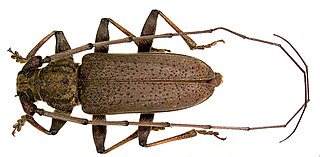
Alcidion is a genus of beetles in the family Cerambycidae, containing the following species:

Achrysonini is a tribe of Long-Horned Beetles in the beetle family Cerambycidae. There are more than 20 genera and 50 described species in Achrysonini. They are found mainly in the Americas, but also in Europe, Asia, and Africa.

Susuacanga is a genus of beetles in the family Cerambycidae, containing the following species:

Stromatium is a genus of beetles in the family Cerambycidae, containing the following species:
Spalacopsis is a genus of beetles in the family Cerambycidae, containing the following species:
Bisaltes is a genus of beetles in the family Cerambycidae, containing the following species:
Metasulenus unicolor is a species of beetle in the family Cerambycidae, and the only species in the genus Metasulenus. It was described by Breuning in 1970.
Sormidomorpha is a monotypic beetle genus in the family Cerambycidae described by Per Olof Christopher Aurivillius in 1920. Its single species, Sormidomorpha unicolor, was described by the same author in the same year.
Falshomelix unicolor is a species of beetle in the family Cerambycidae, and the only species in the genus Falshomelix. It was described by Stephan von Breuning in 1956.
Piola is a genus in the long-horned beetle family Cerambycidae. There are about six described species in Piola, found in the Neotropics.
Paromelix unicolor is a species of beetle in the family Cerambycidae, and the only species in the genus Paromelix. It was described by Quedenfeldt in 1883.

Trichohestima unicolor is a species of beetle in the family Cerambycidae. It was described by Breuning in 1959.
Piola unicolor is a species of Long-Horned Beetle in the beetle family Cerambycidae. It is known from Brazil.
Allogaster is a genus of beetles in the longhorn beetle family. Its first appearance was believed to be around 125.45 million years ago. They are mainly found in sub-Saharan Africa.
Allogaster nigripennis is a species of beetle in the longhorn beetle family native to Sudan.
Allogaster aethiopicus is a species in the longhorned beetle family Cerambycidae. It is known from Eritrea and Ethiopia.
Allogaster bicolor is a species in the longhorned beetle family Cerambycidae, found in the Democratic Republic of the Congo.
Allogaster drumonti is a species in the longhorned beetle family Cerambycidae, found in the Democratic Republic of the Congo.
Allogaster geniculatus is a species in the longhorned beetle family Cerambycidae. It is found in Mali, DR Congo, Niger, Ivory Coast, Gambia, and Sénégal.
Allogaster niger is a species in the longhorned beetle family Cerambycidae. It is found in Nigeria.




